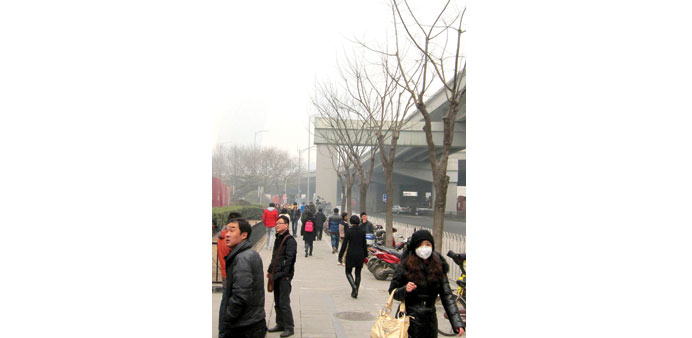SMOKESCREEN: China’s landmark CCTV building, where state television is housed, could barely be seen in this photo of pedestrians walking near the Guomao subway station in Beijing. The CCTV building is one of the city’s most recognised pieces of architecture.
By Steff Gaulter
|
|
Beijing is legendary for its pollution, but a new study is now suggesting that the poor air quality in Asia is affecting the weather elsewhere in the globe. The study by researchers at Texas A&M University in the USA has found that smog from Asia directly affects the weather in North America.
It is already common knowledge that the weather around the world is linked, and what happens in one place can have a dramatic effect on the weather elsewhere in the globe. The same principle applies to pollution: it can have a far-reaching impact.
The usual path of weather systems from Asia is across the Pacific towards North America. If there is bad air quality in Asia, then it is logical that some of the pollution will be carried across the sea towards the shores of North America.
This pollution, or smog, comprises various tiny particles, from sulphates and nitrates, to soot and soil dust. According to the latest research, these particles are causing some storms to become more severe.
In order for water vapour in the atmosphere to become a water droplet within a cloud, it must have something on which to condense. It condenses onto a particle known as a nucleus. This is an incredibly small particle, around 0.006 mm (0.0002 inches), but could be made of anything, from the sea salt in the ocean to soil dust.
If there are no nuclei, then a cloud will struggle to form. Scientists at Texas A&M University argue that the particles in the smog provide a source for these nuclei, and the study found they can increase the formation of deep convective clouds, by between 20 and 50%.
This would mean that clouds are becoming larger and bringing more rain; but more research is needed in order to determine exactly how the pollution is changing the weather in North America. If the pollution is also changing the track of storms, there could be a risk that it is exacerbating the drought in California. For those living in Canada and the USA, this research means that the pollution in Asia is suddenly a local issue.
Two of the world’s three largest contributors of man-made pollution are in Asia: China and India. Both countries have experienced widespread economic growth in recent years. Large, dirty factories and power plants, combined with the effects of wood and coal burning stoves, have increased the levels of smog exponentially.
Both countries are fully aware of their air-quality problems. In China, the government has enforced strict measures in Beijing in to attempt to combat the problem. However, the issues are not only confined to the capital. The Beijing Environmental Protection Bureau announced this month that a third of the pollution in the capital actually comes from outside the city.
Significant levels of pollution come from the surrounding provinces, including Hebei, home to seven of China’s 10 most polluted cities. North America is essentially downwind from Asia, so the problems are fairly logical. However, in the past, the link has been slightly more complex.
A number of research papers have shown that the drought which struck West Africa in the 1980s was caused, at least in part, by the coal-burning factories in the USA and Europe. The pollution caused by these factories cooled the entire northern hemisphere, resulting in the seasonal African rains shifting southwards.
This had a devastating effect in many parts of Africa, particularly the Sahel – the semi-arid grasslands that lie between the vast Sahara and the dense foliage of the African Rainforest. Crops in the Sahel are grown close to their limits of tolerance, and rely on natural rainfall. This means that even small changes to the amount of rain can have disastrous effects. In the 1980s, when the rains in the region failed year after year, thousands people died of starvation.
Although the drought is believed to have been partly due to the natural cycle of drought that happens in this region, it was found to have been exacerbated by the pollution in the northern hemisphere. The drought eased after clean-air legislation was passed in the USA and Europe, allowing the atmosphere to clear, and the rain band to shift northwards once more.
Human activity can, and does, change the weather, and not in just one location. The world’s weather is intricately linked, so what happens in one part of the world, can greatly impact elsewhere.
If more evidence is found to support the theory that the weather in the USA is being adversely affected by the pollution in Asia, it will be a bitter pill for many to swallow and may well play a role in future politics.
However, it may be worth bearing in mind that whilst China and India are two of the three largest contributors of man-made pollution, the country in second place is the United States. What its pollution is doing to other parts of the globe is, as yet, unknown.



